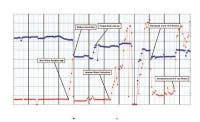Gulf of Mexico oil production forecast to reach record high
David Paganie, Managing Editor
Gulf of Mexico oil production is forecast to increase substantially over the next few years, possibly reaching 1.9 MMb/d in 2013 which would be a record high, according to Richie Baud, MMS deputy regional supervisor for the Office of Production and Development. This is MMS’ best-case scenario, which factors in industry-announced discoveries and undiscovered resources.
Recent startups at BP-operated Thunder Horse (capacity: 280 Mb/d oil; 200 MMcf/d gas), BHP-operated Shenzi (capacity: 100 Mb/d oil; 50 MMcf/d gas), Chevron-operated Tahiti (capacity: 125 Mb/d oil; 70 MMcf/d gas), and volumes of oil and gas production coming back online from hurricane shut-ins, are reversing the GoM oil production trend upward, albeit temporarily, beginning this year. MMS says 75% of the increase in oil production and 72% of the increase in gas production will result from hurricane shut-ins coming back online.
Other recent deepwater startups include BP’s Dorado and King South projects. Dorado comprises three subsea wells; King South has one. Both are tied back to the BP-operatedMarlin TLP.
Meanwhile, based on existing shallow water and deepwater operator commitments, GoM natural gas production is forecast to increase slightly this year over last year, to about 7 bcf/d, according to MMS. However, in 2010, gas output is forecast to begin declining again, even with the addition of resources from industry announced discoveries. The small contribution to gas production from industry announced discoveries reflects the overall trend of lower gas-oil ratios in the subsalt Miocene and Lower Tertiary plays, found in the deepwater GoM.
“The Gulf of Mexico is one of the single largest suppliers of oil and gas to the US market,” says Lars Herbst, MMS GoM regional director. “With continued interest and activity in deepwater areas of the GoM, we anticipate that oil production will continue to be strong with a large portion of production coming from projects in deeper water depths.” Deepwater supplies about 70% of the oil and 36% of the gas from the Gulf. There are 7,310 active leases in the US GoM, 58% of which are in deepwater.
In 2008, operators announced 15 new deepwater discoveries, almost double the number reported in 2007. Seven new deepwater projects (Bass Lite, Neptune, Blind Faith, Mississippi Canyon block 161, Raton, Thunder Horse, and Valley Forge) began production last year, bringing the total to 141. This is up from 130 at the end of 2007. Meanwhile, 73% of the tracts receiving bids in the three GoM lease sales held in 2008 are in deepwater.
Much of the new development in the GoM is in ultra deepwater (water depths greater than 5,000 ft [1,524 m]), and often targeting high temperature and high pressure prospects beneath salt canopies with layers of tar, which complicates drilling and production. This requires rigs equipped with the latest technology, and production systems suited for harsh weather, in areas with minimal existing infrastructure.
“The deepwater frontier has entered a new phase,” says Mike Prendergast, MMS chief of staff, GoM region. He points to the increasing use of hub facilities as a trend in deepwater development. “Hub facilities will serve a bigger role as drilling moves to deeper waters, and this will require further development of MODU technology as many of the hubs lack drilling capacity,” he says.
Chevron recently announced it has initiated front-end engineering and design of a new deepwater hub to develop the Jack and St. Malo discoveries. The floating production platform will be a semisubmersible designed facility with an initial nameplate capacity between 120,000 and 150,000 b/d of oil, 37.5 MMcf/d of gas, and provision for a future 200,000 b/d of water injection. It will be moored in 7,000 ft (2,134 m) of water. Mustang won the contract for topsides FEED, with completion expected in 2Q 2010.
BP is considering a new hub as one of several development options for its Kodiak and Tubular Bells discoveries. The company has appointed AMEC to evaluate the development options, with the aim of advancing the preferred solution into FEED.
Many of the newbuild MODUs scheduled for delivery to the GoM will be equipped with DP systems, and capable of drilling in up to 12,000 ft (3,658 m) of water to 40,000 ft (12,192 m) TD. In 2007, MMS reported a record number of rigs (15) drilling in ultra deepwater. Although this record has not been surpassed, MMS expects increased drilling in this water depth, with 15 newbuild MODUs scheduled for delivery to the GoM in 2009-2011. MMS expects two new drillships and six new semisubmersibles in this year, five new drillships and one semisubmersible in 2010, and one new semisubmersible in 2011. Also, four semisubmersible rigs are being upgraded to drill in ultra deepwater, with delivery to the GoM expected in this year and in 2010.
Meanwhile, a number of production-related technologies considered new to the GoM have been installed recently or are slated for installation in this year.
ATP plans to install its MinDOC floating drilling and production unitATP Titan on the Mirage field for the Telemark Hub project. The company says this is the first-ever multi-column deep draft floating dry tree platform, first platform in the US to be built in a graving dock (pictured above), and the first use in the GoM of a single barrier drilling riser backed by a subsea isolation device. The MinDOC, designed by Bennett & Associates, looks like a semisubmersible but behaves like a spar in terms of stability and dynamic response to waves, according to Bennett. It has capacity for 25,000 b/d of oil and 50 MMcf/d of natural gas. First production is expected by early 2010.
The first FPSO in the US GoM,BW Pioneer, will develop the Cascade and Chinook fields in Walker Ridge, with first production expected in 2010. This project will use four technologies considered new to the Gulf: free-standing hybrid risers, polyester mooring, electric submersible booster pumps, and oil shuttle tankers.
Another first for the Gulf will be the ship-shaped floating production unit,Helix Producer I, for the Phoenix development in Green Canyon, with a planned production startup in 2010. A disconnectable transfer system will be used to connect the field’s subsea wells to the FPU, also a first for the US GoM.
Also scheduled to begin production in 2010 is the Perdido Regional Development in Alaminos Canyon. The project’s truss spar was installed in over 8,000 ft (2,438 m) of water which set a record for the deepest such facility in the world. Perdido is the first application of full, host-scale subsea separation and boosting in the US Gulf.
“The offshore energy industry continues to confront and overcome technological challenges as energy production moves into deeper waters,” says Herbst.
Continuing with the theme of new technology in the GoM, ABS has provided basic design approval for Petrobras’ Mono-Column, Production, Storage, and Offloading unit (MPSO) intended for ultra deepwater operation in the GoM. ABS says the approval is significant as it consolidates the MPSO design concept as one viable option for the next phase of the Cascade-Chinook development. The concept is also being considered for offshore Brazil.
ABS provided an early conceptual stage review of the design and issued its approval in principle in 2005.
The MPSO has some characteristics of a spar but a much shallower draft, explains Luiz Feijo, ABS project manager for the MPSO. The design is such that it minimizes heave and pitch, making it more suitable for the application of steel catenary risers, he says. Also, this new hull design is intended to reduce heave, thus lessening the fatigue on SCRs, adds Feijo.
The MPSO was designed to be permanently moored to the seabed, remaining on station for its operational life. ABS says this presents a major advantage over the traditional ship-shaped FPSO which requires a disconnectable turret due to the harsh environmental characteristics of the GoM.
ABS says it assessed the MPSO for its hull strength by evaluating load components, conducting fatigue assessments, and reviewing the Global Motions and Stability reports. The classification society also conducted a Hazards Identification Study (HAZID) to identify possible safety issues associated with the offloading system. Feijo says the intent is for offloading to be carried out using DP-2 shuttle tankers. ABS provided its approval of the DP system on the shuttle tanker design as well. Since the unit is slated for the GoM, ABS also has provided regulatory compliance assistance to Petrobras.
Petrobras and Japan Oil, Gas and Metals National Corp. (JOGMEC) have been working jointly toward the practical application of the MPSO concept together with partners National Maritime Research Institute (NMRI) and IHI Group in Japan. The unit calls for storage capacity of 800,000 barrels.
It is important to note that Petrobras has not made a decision to launch a second phase of Cascade-Chinook. The company has taken a phase approach to develop the fields, but subsequent phases are contingent on wells results and reservoir performance in Phase 1, according to Petrobras.
Editor’s note: Many of the facts and figures in this article were derived from two recent MMS reports: Gulf of Mexico Oil and Gas Production Forecast: 2009-2018, and Deepwater Gulf of Mexico 2009: Interim Report of 2008 Highlights.
Graving dock recognized for innovation
The graving dock currently containing the hull ofATP Titan was awarded a gold medal in the Engineering Excellence Award Competition held by the Texas Council of Engineering Companies. The Texas Council honors and recognizes outstanding achievements in engineering based on uniqueness, originality, technical design, value to the engineering profession, complexity, and how successfully the project met the needs of the client.
ATP says this is the first graving dock for offshore construction in the US. It is being used to fabricateATP Titan’s hull. The graving dock, at Gulf Marine Fabricators’ yard in South Texas, measures 600 ft (183 m) long by 250 ft (76 m) wide and 40 ft (12 m) deep. It has a reinforced concrete slab floor and sheet pile walls. Around the perimeter, the graving dock has pile supported relieving platforms to take the surcharge load applied by cranes. The south end of the graving dock that opens to the Corpus Christi Ship Channel has a removable sheet piled wall supported by steel struts. When flooded, the graving dock will have a minimum of 30 ft (9m) of water over the concrete floor.
When the hull construction is completed, the graving dock will be flooded and the sheet piles and sand separating the dock from the channel will be removed allowingATP Titan to float out of the dock and be towed to sea avoiding the need to lift the 18,000-ton (16,329-metric-ton) hull onto a barge, thereby reducing cost from the construction process, according to ATP.





